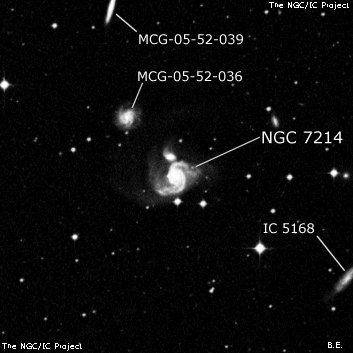
John Herschel discovered NGC 7214 = h3926 on 30 Jul 1834 and recorded "a vS cluster or resolvable nebula; irreg R; lbM; 2' diam; has 2 or 3 stars larger than the rest." His position is accurate. Herbert Howe, observing with the 20" refractor in Denver in 1898-99, remarked "h calls this a globular cluster. To me it appeared to be a nebula having a nuclear condensation of mag 12; the surrounding nebulosity was indefinite in extent."I
In 1915 Knox-Shaw reported it was a not a globular cluster, but an open spiral, based on a photograph taken between 1912-13 the Helwan Observatory with the Reynolds reflector. Based on imges taken 1914-16 it was described as "spiral with two arms, lE 90°, vB stellar nucleus with faint star following 15"."
400/500mm - 17.5" (10/13/90): fairly faint, very small, slightly elongated, very small very bright core, a mag 13 star is just off the SW end, 1.1' from center. This galaxy is the brightest of four in HCG 91. An almost stellar companion, MCG -05-52-035 = HCG 91D, is 30" NNE, MCG -05-52-036 = HCG 91C 2.2' NE and MCG -05-52-039 = HCG 91B 5' NNE.
600/800mm - 24" (9/6/18): NGC 7214 is the dominant member of the HCG 91 quartet. It appeared moderately bright, moderately large, ~50" diameter, well concentrated with a well-defined bright core that increased to the center and a fainter, slightly irregular halo (no spiral structure, though). HCG 91D is barely off the north edge and appeared fairly faint, very small, round, ~0.3' diameter, very small brighter nucleus with a stellar peak.
ESO 467-011 (misidentified as IC 5168), located 5.6' SW of NGC 7214, was a threshold object and popped a couple of times at 220x as a thin edge-on, ~5:1 NW-SE. A number of faint ESO galaxies surround HCG 91, including ESO 467-17 21' ESE, ESO 467-16 19' NNE, ESO 467-5 36' WSW.
Notes by Steve Gottlieb